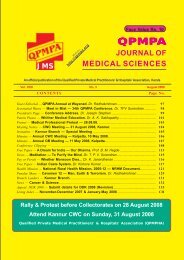QPMPA Journal September 2011 - Qualified Private Medical ...
QPMPA Journal September 2011 - Qualified Private Medical ...
QPMPA Journal September 2011 - Qualified Private Medical ...
Create successful ePaper yourself
Turn your PDF publications into a flip-book with our unique Google optimized e-Paper software.
science<br />
○ ○ ○ ○ ○ ○ ○ ○ ○ ○ ○ ○ ○ ○ ○ ○ ○ ○ ○ ○ ○ ○ ○ ○ ○ ○ ○ ○ ○ ○ ○ ○ ○ ○ ○ ○ ○ ○ ○ ○ ○ ○ ○ ○ ○ ○ ○ ○ ○ ○ ○ ○ ○ ○ ○ ○ ○ ○ ○<br />
Francois Jacob, Jacques Monod and<br />
their colleagues discovered that genes<br />
were co-ordinately controlled. E. coli does<br />
not make enzymes for metabolizing sugar<br />
in milk, but when placed in a medium<br />
with lactose, genes to produce enzymes<br />
metabolizing that sugar are induced.<br />
Work showed that the inducer (whatever<br />
it may be) deactivated a repressor and<br />
stopped synthesis of the messenger RNA.<br />
The group of co-ordinately controlled<br />
genes and their regulatory DNA sites was<br />
called “Operon”. It was assumed that<br />
this model might prove to be the way<br />
genes control organisms undergoing<br />
embryological development.<br />
As most cells in developing organisms<br />
seemed to have the same amount of DNA,<br />
it had long been a puzzle how they differentiated<br />
into the many different cell types<br />
in the body. However, further work<br />
showed that gene regulation is far more<br />
complex. In addition, behaviour of the<br />
nervous system was found to be extremely<br />
strange at molecular level. Returning to<br />
fruit flies, Seymour Benzer induced behavioural<br />
mutations in it. Sydney Brenner<br />
developed the nematode worm,<br />
Caenorhabditis elegans, to study its nervous<br />
system and genetics of behaviour.<br />
Nirenberg used neuroblastomas to study<br />
development of neural tissue.<br />
Molecular biology enabled numerous<br />
other fields to go molecular. Descriptive<br />
cytology turned into molecular. The immunological<br />
relationship between antibodies<br />
and antigens was re-characterized<br />
at the molecular level. However, not<br />
all attempts to find the molecular basis<br />
of biological phenomena met with success,<br />
like the claim that RNA molecules<br />
coded memories. In the 1970s, molecular<br />
biology itself was going genomic. The<br />
genome is a collection of nucleic acid<br />
base pairs (adenine pairs with thymine<br />
and cytosine with guanine). The number<br />
of base pairs varies widely among species.<br />
For example, H. influenza has<br />
roughly 1.9 million base pairs while a<br />
Watson<br />
Homo sapiens sapiens has more than<br />
3 billion. Genomics owes much to the<br />
development of new computational<br />
methods for producing, storing, and interpreting<br />
long sequences of enormous<br />
amounts of data.<br />
Frederick Sanger developed proteinsequencing<br />
techniques and used them<br />
to elucidate the amino acid sequence of<br />
insulin. Kary Mullis developed polymerase<br />
chain reaction, a procedure wherein<br />
small samples of DNA were amplified. In<br />
the mid 1980s, USA originated a project<br />
to sequence human genome (initially to<br />
determine the impact of radiation on<br />
humans induced by atom bombs in Japan).<br />
While the human genome received<br />
most of public attention, hundreds of<br />
other genomes including cat, mouse, and<br />
rice were sequenced. One of the startling<br />
revelations was… the human genome<br />
contained 20,000 to 25,000 genes; the<br />
Crick<br />
cats have 20,285 genes, the mouse<br />
24,174, and rice a whopping 50,000. Rice<br />
was more complex than man was. However,<br />
just as a number of disciplines “went<br />
molecular”, molecular biology itself was<br />
wrestling with complexities posed by split<br />
genes and overlapping genes and how a<br />
mere 20,000 genes can construct a human<br />
while a grain of rice requires 50,000<br />
genes. Thus, genomics is now supplemented<br />
by post-genomics.<br />
Developments in genomics and postgenomics<br />
have sparked a number of<br />
philosophical questions about molecular<br />
biology. Since the genome requires a<br />
vast array of other equally indispensable<br />
mechanisms to make a protein product,<br />
can DNA alone really be causally<br />
prioritized. Similarly, in the face of such<br />
interdependent mechanisms involved in<br />
transcription, regulation, and expression,<br />
can DNA alone be privileged as the bearer<br />
of hereditary information? Or is the information<br />
distributed across all such<br />
entities and activities? In addition, if so,<br />
how should be this systems-level analysis<br />
conceptualized? Is post-genomics<br />
simply a collection of mechanisms, or is<br />
there ‘something’ epistemologically and<br />
metaphysically stable that controls systems<br />
and mechanisms? What actually is<br />
this ‘information?’<br />
Genes as linear DNA sequences of bases<br />
carry “information” for the production<br />
of proteins. During protein synthesis,<br />
the information is “transcribed” from<br />
DNA to messenger RNA and then translated<br />
to proteins. During DNA replication,<br />
and subsequent inheritance, it is<br />
often said that what is passed to the<br />
next generation is the “information” in<br />
the genes, namely the linear ordering<br />
of bases along DNA strands. Historians<br />
of biology have tracked the information-talk<br />
of molecular biology, and<br />
philosophers of biology have doubted<br />
whether a definition of “information”<br />
can be provided at all that adequately<br />
captures its usage in this field.<br />
○ ○ ○ ○ ○ ○ ○ ○ ○ ○ ○ ○ ○ ○ ○ ○ ○ ○ ○ ○ ○ ○ ○ ○ ○ ○ ○ ○ ○ ○ ○ ○ ○ ○ ○ ○ ○ ○ ○ ○ ○ ○ ○ ○ ○ ○ ○ ○ ○ ○ ○ ○ ○ ○ ○ ○ ○<br />
120<br />
<strong>QPMPA</strong>.JMS . Vol. XXV . No. 3 . June-Sept. <strong>2011</strong>



